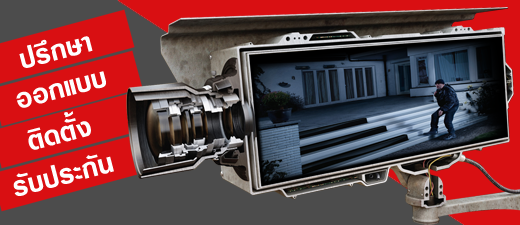หน้าแรก >> CCTV Surveillance
Video’s Critical Role in the Security Plan
1.1.2 Background
Throughout history, humans have valued their own life and the lives of their loved ones above all else. Next Video’s Critical Role in the Security Plan 3 in value has been their property. Over the centuries many techniques have been developed to protect property against invaders or aggressors threatening to take or destroy it.
In the past as in the present, manufacturing, industrial, and government organizations have hired “watchmen” to protect their facilities. These private security personnel wearing uniforms and using equipment much like the police do are hired to prevent crime and bodily harm, and deter or prevent theft on the premises. The very early guard companies were Pinkerton’s and Burns. Contract protection organizations were hired to safeguard their employees and assets in emergency and personal threat situations.
A significant increase in guard use came with the start of World War II. Many guards were employed to secure industrial work sites manufacturing military equipment and doing classified work, and to guard government facilities. Private corporations obtained such protection through contract agencies to guard classified facilities and work.
In the early 1960s, as electronic technology advanced, alarm systems and video were introduced. Radio Corporation of America (RCA), Motorola, and General Electric were the pioneering companies that began manufacturing vacuum-tube television cameras for the security industry.
The use of video cameras during the 1960s and 1970s grew rapidly because of increased reliability, lower cost, and technological improvements in the tube-type camera technology. In the 1980s growth continued at a more modest level with further improvements in functions and availability of other accessories for video security systems.
The most significant advance in video technology during the 1980s was the invention and introduction of the solid-state video camera. By the early 1990s the solid-state camera using the charged coupled device (CCD) image sensor was the choice for new security installations and was rapidly replacing the tube cameras. In the past, the camera—in particular, the vidicon tube sensor—was the critical component in the video system. The camera determined the overall performance and quality of visual intelligence obtainable from the security system. The vidicon tube was the weakest link in the system and was subject to degradation with age and usage. The complexity and variability of the image tube and its analog electrical nature made it less reliable than the other solid-state components. Performance varied considerably between different camera models and camera manufacturers, and as a function of temperature and age. By contrast, the solid-state CCD sensor and newer metal oxide semiconductor (MOS) and complimentary MOS (CMOS) sensor cameras have long life and are stable over all operating conditions. Another factor in the explosive use of video in security systems has been the rapid improvement in equipment capability at affordable prices. This has been the result of the widespread use of solid-state camcorders by consumers (lower manufacturing costs), and the availability of low-cost video cassette recorders (VCRs), digital video recorders (DVRs), and personal computer (PC)-based equipment.
The 1990s saw the integration of computer technology with video security technology. All components were solid state. Digital video technology needed large-scale digital memories to manipulate and store video images and the computer industry had them. To achieve satisfactory video image transmission and storage, the video signal had to be “compressed” to transmit it over the existing narrowband phone line networks. The video-computer industry already had compression for broadcast, industrial, and government requirements. The video industry needed a fast and low-cost means to transmit the video images to remote locations and the US government’s Defense Advanced Research Projects Agency (DARPA) had already developed the Internet, the predecessor of the World Wide Web (WWW). The Internet (and intranet) communications channels and the WWW now provide this extraordinary worldwide ability to transmit and receive video and audio, and communicate and control data anywhere.
















